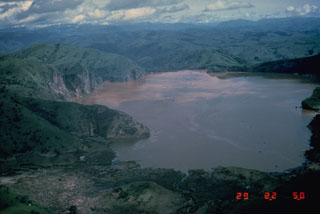Report on Oku Volcanic Field (Cameroon) — August 1985
Scientific Event Alert Network Bulletin, vol. 10, no. 8 (August 1985)
Managing Editor: Lindsay McClelland.
Oku Volcanic Field (Cameroon) Fatal 1984 gas emission may have been caused by sudden release of dissolved CO
Please cite this report as:
Global Volcanism Program, 1985. Report on Oku Volcanic Field (Cameroon) (McClelland, L., ed.). Scientific Event Alert Network Bulletin, 10:8. Smithsonian Institution. https://doi.org/10.5479/si.GVP.SEAN198508-224030
Oku Volcanic Field
Cameroon
6.25°N, 10.5°E; summit elev. 3011 m
All times are local (unless otherwise noted)
In March 1985, Haraldur Sigurdsson, J.D. Devine, and F. Tchoua investigated the August 1984 event. The following briefly summarizes their findings; Sigurdsson and others have submitted a paper for publication and they will also present their data in December at the American Geophysical Union meeting in San Francisco.
On 15 August at about 2330, several people heard a loud noise or explosion from the Lake Monoun area and there were unconfirmed reports that an earthquake was felt that day at a town 6 km N of the lake. The gas cloud was emitted from the E part of the lake, where a crater about 350 m in diameter and at least 96 m deep is located. Victims of the cloud were in a low-lying area and had apparently died between 0300 and dawn. No autopsies were performed and the exact causes of death are unknown; all bodies had suffered skin damage [corrected from first-degree burns]. Persons on the fringes of the cloud reported that it smelled bitter and acidic. From 0630 until it dissipated by 1030, the whitish, smoke-like cloud remained 0-3 m above the ground. Vegetation was flattened within 100 m of the lake's east end, indicating that a water wave as much as 5 m above lake level was associated with the event.
Lake Monoun is near the center of a volcanic field that includes at least 34 recent craters, and there is evidence that eruptive activity has occurred there as recently as a few hundred years ago. However, the chemistry of the lake water and sediments, the uniformly low lake temperature (23-24°C), and the absence of new tephra in or around the lake suggested to the research team that the August 1984 event was not the result of an eruption or a sudden ejection of volcanic gas from the lake. Gradual emission of CO2 from volcanic vents is thought to have led to a buildup of HCO3 in the lake. An earthquake or internal seiche is thought to have upset the density stratification of the lake, triggering its overturn and catastrophic exsolution of CO2, which suffocated the victims. Explanations of the cloud's acid odor and the agent of victims' skin damage are uncertain.
[Two years later, 1,700 people perished 100 km to the NNW (figure 1) when CO2 was suddenly exsolved from Lake Nyos and flowed down several inhabited valleys. Results of initial research on this newly recognized hazard are summarized by Sigurdsson (1987), drawing substantially on discussions at the March 1987 international conference in Yaoundé, Cameroon.]
Further References. Tchoua, F.M., 1983, The phreatomagmatic explosions of Monoun: Rev. Sci. Tech., v. 3, p. 87-97.
Sigurdsson, H., Devine, J.D., Tchoua, F.M., and others, 1987, Origin of the lethal gas burst from Lake Monoun, Cameroon: JVGR, v. 31, p. 1-16.
Sigurdsson, H., 1987, Lethal gas bursts from Cameroon crater lakes: EOS, v. 68, no. 23, p. 570-573.
Geological Summary. Numerous maars and basaltic cinder cones lie on or near the deeply dissected rhyolitic and trachytic Mount Oku massif along the Cameroon volcanic line. The Mount Oku stratovolcano is cut by a large caldera. The Oku volcanic field is noted for two crater lakes, Lake Nyos to the N and Lake Monoun to the S, that have produced catastrophic carbon-dioxide gas release events. The 15 August 1984 gas release at Lake Monoun was attributed to overturn of stratified lake water, triggered by an earthquake and landslide. The Lake Nyos event on 21 August 1986 caused at least 1,700 fatalities. The emission of ~1 km3 of magmatic carbon dioxide has been attributed either to overturn of stratified lake waters as a result of a non-volcanic process, or to phreatic explosions or injection of hot gas into the lake.
Information Contacts: H. Sigurdsson, Univ. of Rhode Island.

